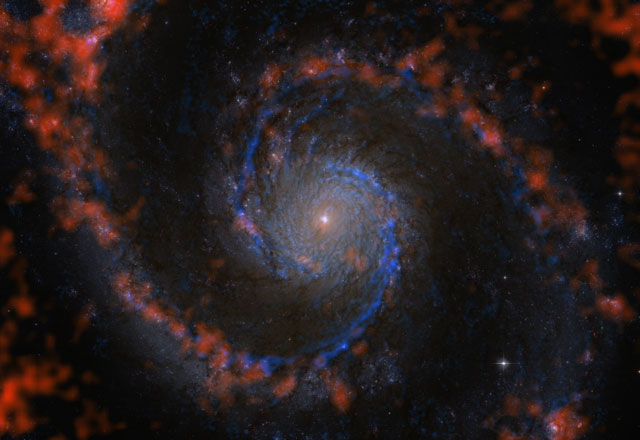News
Cloud atlas reshapes astronomers’ views of stellar birthplaces
A multi-year study of the Whirlpool galaxy (M51) has shaken up astronomers’ views of the properties of giant molecular clouds. The new study, which mapped 1,500 such clouds, shows that, instead, they are embedded in a kind of fog of molecular hydrogen much more dense than anyone expected, which permeates the whole of the galactic disc. Pressure exerted by this fog is crucial in determining whether or not new stars will form within the clouds. The study, led by Eva Schinnerer from the Max Planck Institute for Astronomy, made extensive use of the millimeter telescopes of IRAM, the Institut de Radioastronomie Millimétrique.
Most of a galaxy’s stars are born within giant molecular clouds - accumulations of hydrogen molecules with total masses between a thousand and several million times that of our Sun. As a region within such a cloud collapses under its own gravity, it contracts until pressure and temperature are high enough for nuclear fusion to set in: a new star is born.
 |
| Molecular hydrogen in the Whirlpool Galaxy M51. The blueish features show the distribution of hydrogen molecules in M51, the raw material for forming new stars. The PAWS team has used this data to create a catalogue of more then 1,500 molecular clouds. The reddish structures show the distribution of hydrogen atoms.
The background is a color image of M51 by the Hubble Space Telescope. Credit: PAWS team/IRAM/NASA HST/T. A. Rector (University of Alaska Anchorage) |
Now, a new study challenges astronomers’ traditional views about these stellar birthplaces. Study leader Eva Schinnerer (Max Planck Institute for Astronomy) explains: “Over the past four years, we have created the most complete map yet of giant molecular clouds in another spiral galaxy similar to our own Milky Way, reconstructing the amounts of hydrogen molecules and correlating them with the presence of new or older stars. The picture that is emerging is quite different from what astronomers thought these clouds should be like.” The survey, known as PAWS, targeted the Whirlpool galaxy, also known as M51, at a distance of about 23 million light-years in the constellation Canes Venatici (“Hunting dogs”).
Annie Hughes, a post-doctoral researcher at MPIA involved in the study, says: “We used to think of giant molecular clouds as solitary objects, drifting within the surrounding interstellar medium of rarified gas in isolated splendor; the main repository of a galaxy’s supply of hydrogen molecules. But our study shows that 50% of the hydrogen is outside the clouds, in a diffuse, disk-shaped hydrogen fog permeating the galaxy!”
This “fog” of surrounding gas plays an important role in star formation. So does a structural feature characteristic of spiral galaxies: the spiral arms, which slowly move through the galaxy like ripples on a lake, and are somewhat more densely filled with stars and gas than the rest of the galactic disk. Sharon Meidt, another MPIA post-doctoral researcher involved in the study, says: “These clouds are definitely not isolated. On the contrary, interactions between clouds, fog, and overall galactic structure appear to hold the key to whether or not a cloud will form new stars. When the molecular fog moves relative to the galaxy's spiral arms, the pressure it exerts on any clouds within is reduced, in line with a physical law known as Bernoulli's principle. Clouds feeling this reduced pressure are unlikely to form new stars.”
Incidentally, Bernoulli's law is also thought to be responsible for part of the well-known shower-curtain effect: shower curtains blowing inward when one takes a hot shower, another display of reduced pressure.
Jerome Pety of the Institut de Radioastronomie Millimétrique (IRAM), which operates the telescopes used for the new observations, says: “It's good to see our telescopes live up to their full potential. A study that needed such extensive observation time, and required both an interferometer to discern vital details and our 30 m antenna to put those details into a larger context, would not have been possible at any other observatory.”
Schinnerer concludes: “So far, the Whirlpool galaxy is one example which we have studied in depth. Next, we need to check that what we have found also applies to other galaxies. For our next steps, we hope to profit from both the extension NOEMA of the compound telescope on the Plateau de Bure and from the newly opened compound telescope ALMA in Chile, which will allow in-depth studies of more distant spiral galaxies.”
Contacts
(IRAM, LERMA/Observatoire de Paris, CNRS,
Université de Cergy-Pontoise, Université Pierre et Marie Curie, ENS)
Tél. : 04 76 82 49 87
Karl Schuster
IRAM
Tél. : 04 76 82 49 08
Public outreach :
Karin Zacher
IRAM
Tél. : 04 76 82 21 03
Background information
The PAWS team consists of Eva Schinnerer (Principal investigator; Max Planck Institute for Astronomy [MPIA]), Dario Colombo (MPIA), Clare Dobbs (University of Exeter), Gaëlle Dumas (IRAM Grenoble), Santiago García-Burillo (Observatorio Astronómico Nacional, Madrid), Annie Hughes (MPIA), Carsten Kramer (IRAM Granada), Adam Leroy (National Radio Astronomy Observatory), Sharon Meidt (MPIA), Jerôme Pety (IRAM Grenoble), Karl Schuster (IRAM Grenoble), and Todd Thompson (Ohio State University).
More information about the project can be found on the IRAM PAWS home page.



